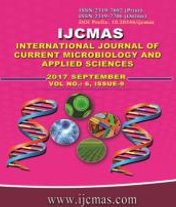


 National Academy of Agricultural Sciences (NAAS)
National Academy of Agricultural Sciences (NAAS)

|
PRINT ISSN : 2319-7692
Online ISSN : 2319-7706 Issues : 12 per year Publisher : Excellent Publishers Email : editorijcmas@gmail.com / submit@ijcmas.com Editor-in-chief: Dr.M.Prakash Index Copernicus ICV 2018: 95.39 NAAS RATING 2020: 5.38 |
The experiment was conducted to study the effect of photosynthetically active radiation (PAR) on growth and development of chrysanthemum using LEDs. The chrysanthemum cv. Zembla were exposed to different photoperiodic treatments of day length extension illuminating from photosynthtically active radiation from LEDs for 6, 9, 12, 15 days at 15h/day in growth chamber except for control. Every batch after exposure at 6, 9, 12, 15 days under red/blue LEDs was transferred to the chamber with white LEDs. All the growth and physiological parameters (plant height, number of leaves, internode length, leaf chlorophyll, leaf area and net photosynthetic rate) differed significantly during different stages of growth and found that the increased in photoperiod by 15 days with long days from LEDs there was an increase in plant height (43.05cm), inter nodal length (2.60cm), number of leaves (24.50) and leaf area (224.83 cm2) cv. Zembla maximum (15 days) exposure in LEDs. Early flower response was noticed which was advanced by 7 days as compared with control. Bud and flower diameter (5.78 mm and 80.74 mm) were maximum. Fresh and dry weight in stems and flower were significant which might have contributed with increased total chlorophyll (4.43 mg g-1 fw) content as application of light emitting diodes (LEDs) might be resulted in long day effect without disturbing the required minimum dark period for flower induction.
 |
 |
 |
 |
 |